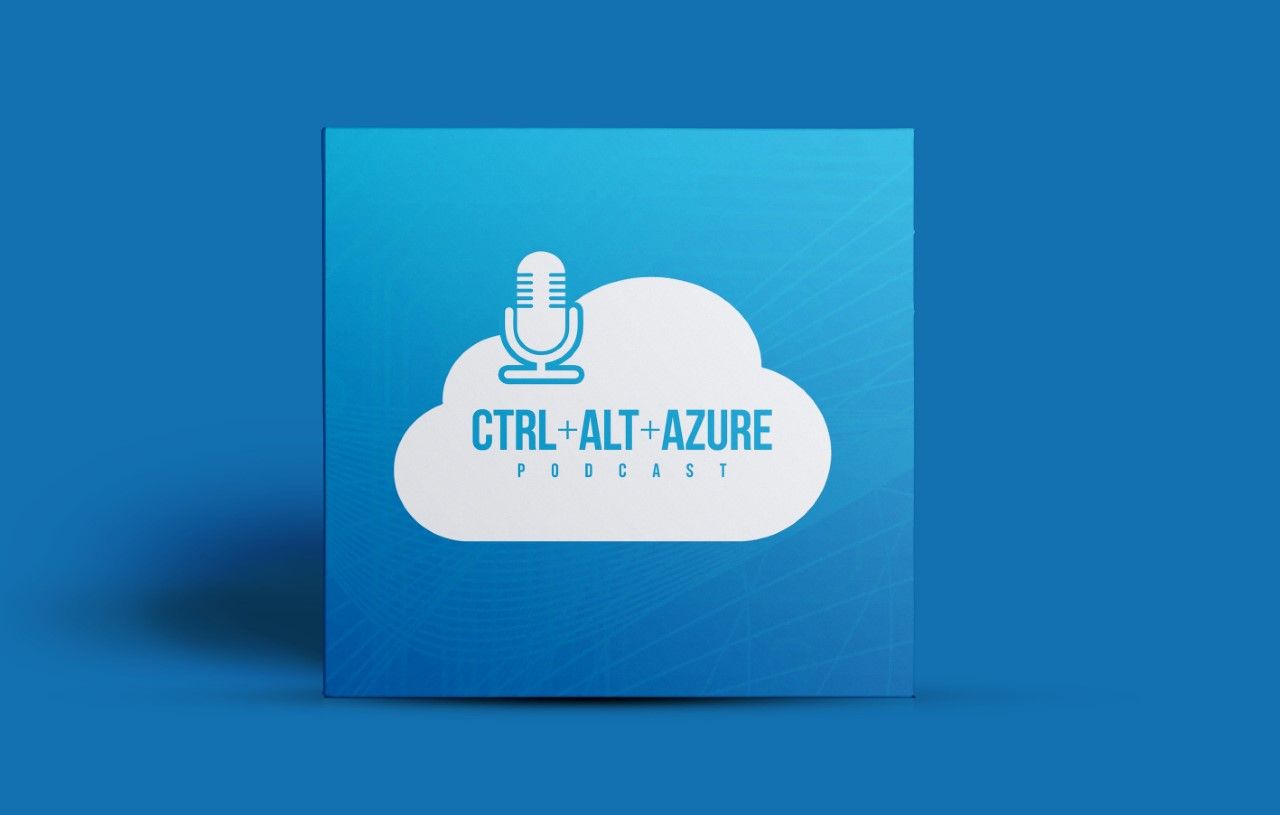
How we planned and launched a Podcast - the technical story
It's 2020, and podcasts are still a thing.
I have never been an avid listener of Podcasts, but I appreciate others are, and I understand the value of the format. After doing some research, I figured it would be great to launch a podcast to see the uptake on the topics we would share.
During 2019, I teamed up with Jussi Roine, and we launched the Ctrl+Alt+Azure Podcast. Jussi also wrote a story about "Getting started with a podcast - the equipment, setup and logistics," and I shared my thoughts in my post "We just launched an Azure podcast."
I want to take another angle to the story and talk about how we go to where we are, and choosing the technical platforms, and how we are doing our weekly recordings.
For reference, here are the episodes in case you've missed them!
Get the background story first
Before going out there and "just launch a podcast," I thought about it for a long time. We're talking about years, not days or months. I always believed that conveying the message both in writing (the blogging) and in audio (the podcast) would be an ideal scenario - I just never found the right angle to do that.
Having a random coffee call with Jussi, we ended up talking about the same topic and that we both had ideas about a Podcast. So we thought, why not combine efforts and do this together? Said and done, here we are.
Why are we doing a podcast?
It started as a set of irregular coffee-calls where we shared war-stories from spending our days in the cloud. In one of these calls, one of us suggested we should record them so others could benefit from the tips and insights, and after a couple of iterations on that idea, we ended up with "Let's do a podcast."
This podcast is what I would refer to as a "hobbyist" podcast, but with seasoned professionals. We spend our time spreading the experience and insights we come across and hope to gain more knowledge along the way, all while its a spare-time project.
Also, it's enjoyable!
Who is our audience?
We have a broad spectrum of the Azure space as our audience, and we see listeners tune in from all kinds of angles.
We cover development, infrastructure, cost and business impact, security, and anything in between. If it's Azure-related, we might talk about it - easy as pie.
What type of show is it?
Generally, when I did my initial research, I had these ideas for shows:
- Solo show, where I was the only one talking. Boring.
- The interview shows where new guests would appear in every episode. It sounded like fun.
- The co-hosted shows format. Where we eventually ended up.
The benefit of choosing the co-hosted show format that Jussi and I are doing is that we already had great coffee calls, and our dialogue just flowed naturally. We can bounce ideas, challenge, or toss questions at one another, and we are learning new things in each episode from one another.
There are some smaller drawbacks we have noticed, but they are mostly about how to find time to record the show. If we plan our episode recordings ahead of time, we usually find a couple of slots that work for both.
If you have tuned in to the show, you'll know that we aim for a weekly release of new episodes, which we've managed to stay true to since we started. Running this podcast is by far one of my more fun spare-time projects, which makes it easy to make time for - even my family approves. Well, at least they think it's super important, and I am on Spotify, which is "cool."
How is the podcast doing?
Generally speaking, we're doing GREAT. 🚀
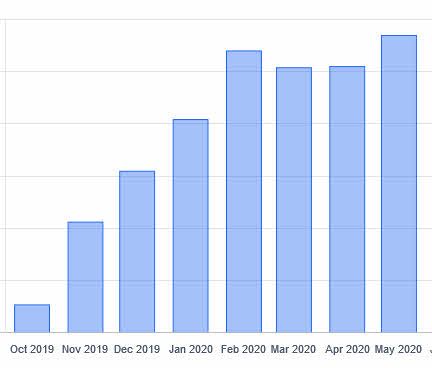
In recent global events with the ongoing pandemic of the Coronavirus, we also see a slight decrease in growth for March. A similar trend seems to be happening for podcasts at large. Read more about the temporary decline in podcast listeners here.
We are both delighted to see such an uptake on show downloads, and that more people are subscribing every day.
When the show is a bit older and the stats are more trustworthy, we'll try to share the actual numbers - until then; it's just speculative growth and nothing to celebrate yet. We're also shy, like typical Scandinavians.
Build a brand for your podcast
Coming back to the classic branding topic, this is something I believe is key to any podcast success. Branding doesn't have to steal much of your time, and in fact, we outsourced most of the work and only spent time on the naming-part ourselves.
The name
Ctrl+Alt+Azure. It has a ring to it. At least we think so ourselves.
What's in a name? Read Jussi's initial blog post about the launch here. It has some great name suggestions we thought about. I'm happy we ended up with the one we have now, even though there's some clear potential in the vast array of brain-farted examples we jotted down :)
I quickly went on to register the domain, https://ctrlaltazure.com.
The visuals
For us, we decided to outsource all visual branding work to help freelancers get some business, but also to quickly get the task done while we were busy with our daily work.
I quickly picked up my Fiverr account and started posting about a Podcast Cover Art project with which I needed help. A day and $15 later, we had a solid piece done from a designer who understood our angle.
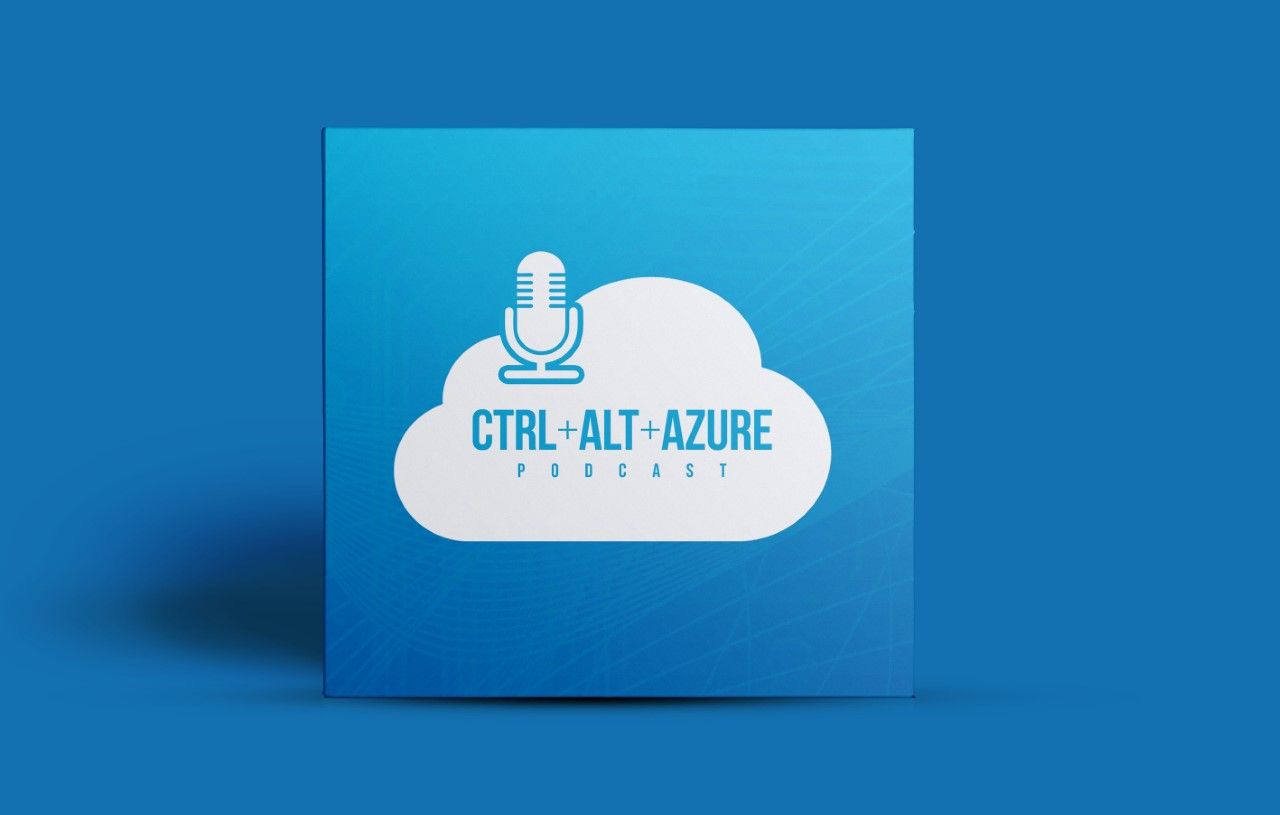
With the right direction and guidance to the designer from my initial requests, we iterated a few times to reach this stunning piece of podcast cover art. Perhaps it would be more stunning with a picture of Jussi and me on it as has been suggested, but let's not taint it just yet.
Let's talk about the technical details
Awesome. I briefly touched on the background of the podcast and some insights along the way. Now I want to take a moment and talk about the technical aspect of the podcast.
- In what channels do we want to reach people?
- Where do we host the podcast (technical platform)?
- Recording software?
- Recording hardware?
- How do you edit the podcast?
Decide how you want to reach people
You've already decided that a Podcast is for you. Great - but how do you reach people with that podcast?
I made an inventory of the channels I found most interesting to get published on. Here's a brief list out of all the options I found:
- Spotify
- iTunes / Apple Podcast
- RSS Feed
- Player.fm
- Stitcher
- TuneIn
- Overcast
- Pocket Casts
- Castro
- Radiopublic
- Castbox
- Breaker Audio
- Google Podcasts
- Google Play Music
- Acast.com
- Pandora
- Soundcloud
- iHeartRadio
The list goes on, but these are the first channels that I found to be popular, and that had traction amongst listeners worldwide. With that information in my bag-of-experiences, I made up my mind that it was more than sufficient to get listed on at least half of those to kick things off.
In retrospect, this is what the analytics of our podcast says today. Looking at the platforms, it was a great choice to include as many publishing channels as possible, allowing the audience to listen through their preferred podcast platform.
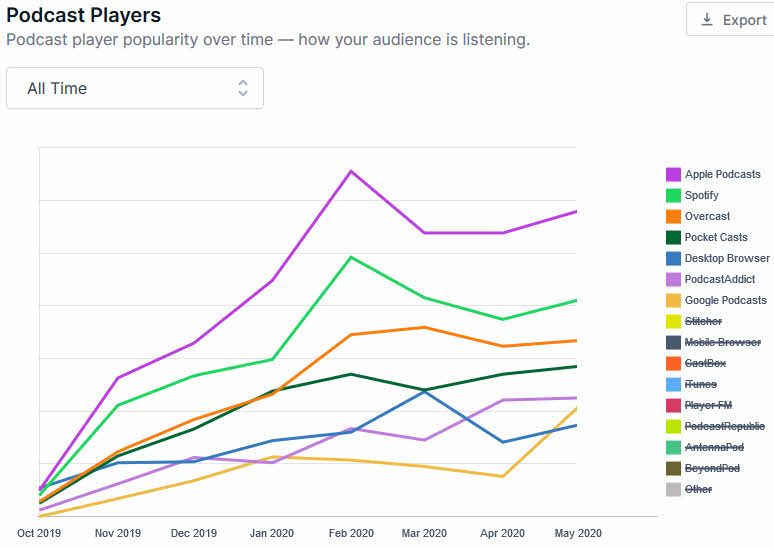
Here are my main takeaways from this stunning visual:
- I've only selected a few of the channels because otherwise, the lines would look like spaghetti bolognese.
- We can see that there's a wild diversity in podcasting platforms that listeners prefer. Allowing listeners to choose their preferred platform was great.
- We can see the COVID-19 effects from mid-March onwards.
- It goes straight down close to the bottom in April. This is because April just started, and the analytics platform doesn't allow me to exclude that month. #facepalm.
- I like the colored charts.
Update June 6th 2020: The trend has recovered from the impact of COVID-19, and we are again seeing a steady growth of downloads and listeners.
Decide on a technical platform
TLDR: We ended up with something called Transistor.fm.
Being a novice in the Podcasting scene, we had a lot of options to try out before we landed on what I think is a perfect platform for launching a podcast.
- Build our own Wordpress site with awesome podcasting plugins.
- Use Ghost Pro as a publishing page and convert the RSS feed to a podcast feed.
- Tinker a bit and set something up in Azure, because why not.
- A plethora of other options came to mind...
In the end, we both agreed that we don't have time to maintain or figure those details out. We are both busy as ever, and doing this in our spare time wouldn't do us well to have to tinker with the technology "just to make it work," even though it would be a fun project if there was more time.
My requirements were easy. I think.
- It shouldn't cost too much.
- It should be a no-hassle, no-maintenance setup.
- I, as a Podcaster, shouldn't have to know or care about any details other than "Click here to upload the audio file" and "Enter show notes and a title here."
- Some type of analytic feature set had to exist. Because I like numbers. Did I mention I particularly enjoy colored charts?
I set out to investigate different podcasting platforms. Surely something had to exist, so we didn't have to craft this ourselves.
In no particular order, here are some of the ones I found to be very popular:
- Podbean.
- BuzzSprout.
- SoundCloud.
- Transistor.fm - this is where we ended up.
- Blubbry.
- Libsyn.
They all seem to have a plethora of functionality from scratch, and they come with various plans. Ranging from Free to a few bucks per month.
After taking them for a spin, we opted for the Transistor.fm platform. I don't think the other platforms are wrong, we just both seemed to like this one, and it doesn't cost too much. I think we get charged ~$20 per month, and we don't have to lift a finger to ensure the success of our podcast launch - other than actually recording a ton of episodes.
Decide on the recording software to use
Now, we decided where we want to publish and what platform to help us do that. But how would we record our episodes? A couple of ideas came to mind:
We initially recorded 2-3 episodes with Zencastr, but quickly experienced the "audio drift" that I've seen others mention in the past. I spent two nights editing two shows because of that, and at this point, I already knew it had defeated the purpose of using something "that just works." Moving on.
We tried Microsoft Teams for one episode. It was actually okay, and we had great sync in the video too. Since we could see one another, it was a lot easier to stay in sync during the chat and align our thoughts visually, also.
Skype was perhaps not the best option we tried.
Since I had access to a paid Zoom account, we tried that. Said and done, we have used Zoom ever since.
We experience a great video and audio sync, and the option of cloud-recording is excellent. As soon as we hang up, I get an e-mail with a link to download either the video or only the audio file.
Deciding on the podcasting hardware
The hardware is the least of the worries for me as long as it's "good enough." If you get into the pro game and want to level up, there's some serious equipment to get, as with anything.
For me, the only piece of additional equipment to my everyday work life is my microphone.
- RØDE Podcaster (USB)
I have my usual headphones and my laptop, and then the microphone mentioned above. That's it. Here's a picture of what my home office looks like, and it includes the equipment for all podcast recordings - it's the white thing hanging next to the monitor on the right side.
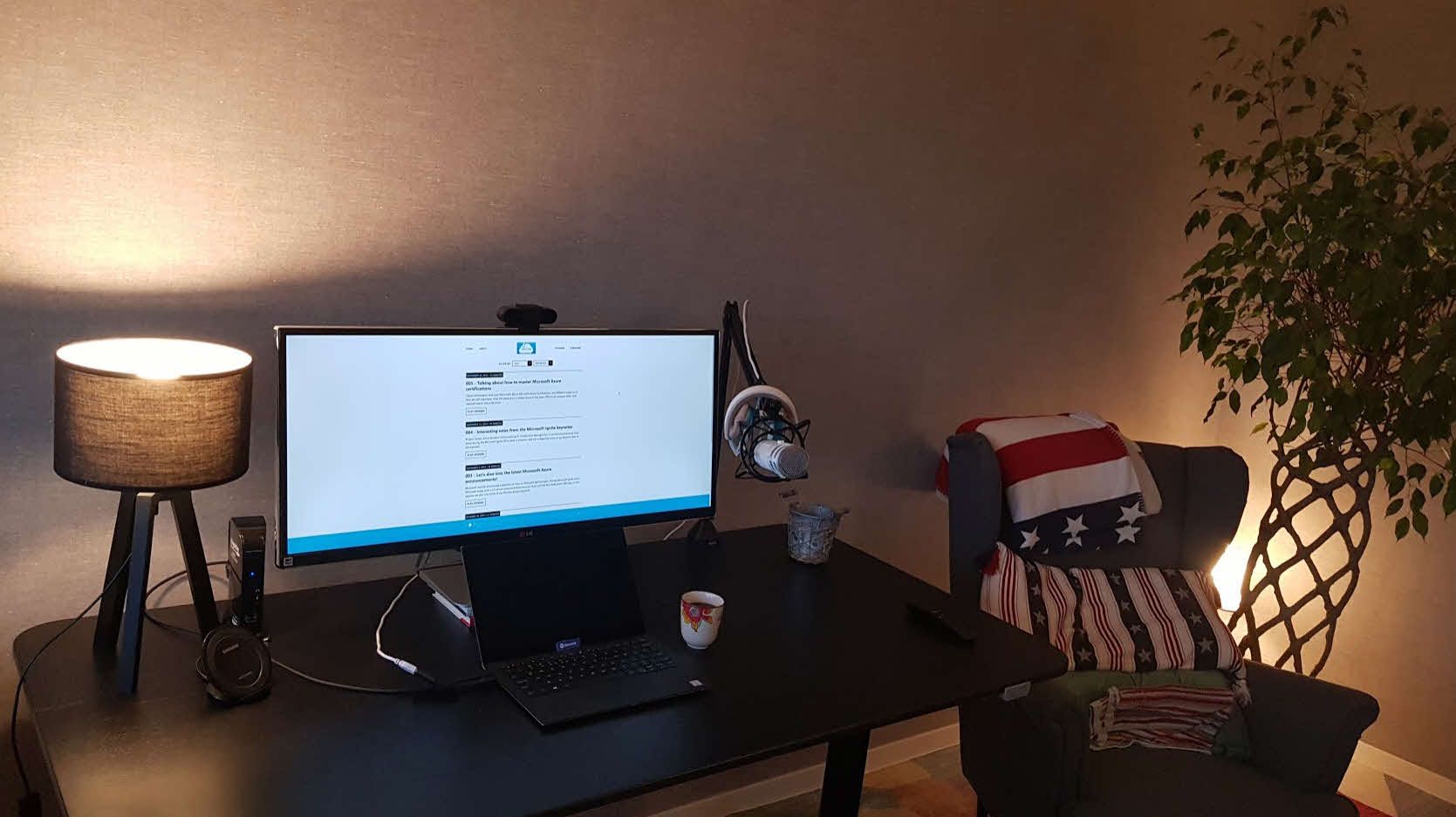
I had to tweak my microphone a few times after the first couple of episodes came out, as I had it configured at 100% volume, which wasn't ideal.
Turning the microphone input down to 90% removes most, if not all, reverb, and I have an excellent recording that sounds awesome both with my studio headphones, as well as on the Sonos.
Meanwhile, Jussi have upgraded his equipment a few notches, as he wrote here.
Editing each episode
I have recorded and published many videos, screencasts, and training in my days. This includes audio editing as well. But let's be honest again for a second; we want to focus on recording a great show and get that published - not tinker and fiddle with audio perfectionism.
We quickly decided to outsource all episode editing to a freelancer. I have used Fiverr a lot in the past, so that was my immediate go-to-plan.
We pay ~$12 per episode, including tax, for the audio editing. This includes:
- Add the intro.
- Add the actual episode recording, and brush up on things that are out of order.
- Add the outro.
- Get the files delivered in the format we require.
I really like to use this approach because it saves us tremendous amounts of time. It also benefits the freelancers with recurring income, and they can deliver super quick because this is what they do every day.
What does the weekly process look like?
To put things into perspective, this is what the weekly process looks like.
- Jussi usually tries to send a few Outlook invites for blockers in the upcoming week(s). Tobias (that's me), accepts one or a few of them, or we go back and forth until we find something that works.
- We keep some notes in OneNote ahead of each recording, so we have a list of titles we want to talk about ready for each blocked calendar entry.
- We jump on the call, and after a bit of chatting, usually about whether we had good coffee or not during the day, we hit the recording button and just start talking. It's really that easy, and we have a great flow. At least I would like to think that we do.
- We finish up, and I get the link to the audio file from Zoom's cloud recording.
- I send this over to our freelancer, and within a day, we usually have the produced episode.
- I put some ID3 tags on the file, and upload it to Transistor along with the title, and Jussi adds show notes and links.
- Iterate.
It's very straight forward, and there's not much to it in the end. We ended up automating a lot by going with an existing podcasting platform, and by outsourcing, we saved more time in the end.
Summary
We love to produce this podcast. I am thrilled to see a significant uptake in listeners, and I am enthusiastic to see all the great comments we are getting. This helps us stay motivated and produce more episodes!
The total cost for the podcast comes close to around $60-80 per month. A month has 4 episodes, which I think is a reasonable price to pay for delegating the responsibility of editing, using the publishing platform, and get great channel-awareness.
In other words, it's roughly 14 cups of coffee in a local coffee shop. 7 cups of coffee each per month, and we only spend time recording and uploading the files. Worth it.
Thanks for reading our story, and I hope it can inspire someone to take the leap of launching their own podcast in the future.
Until next time! See you then.



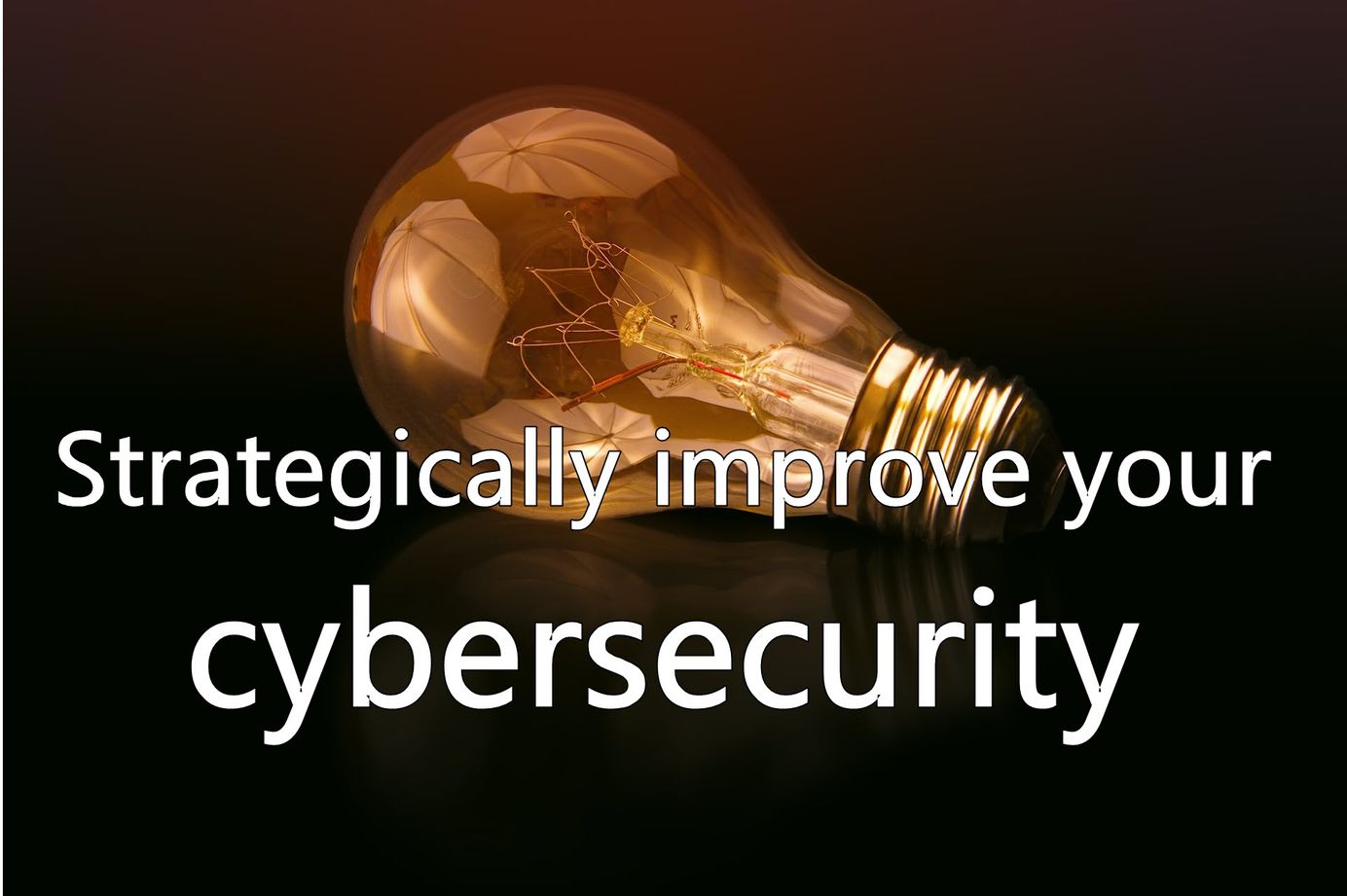




Recent comments